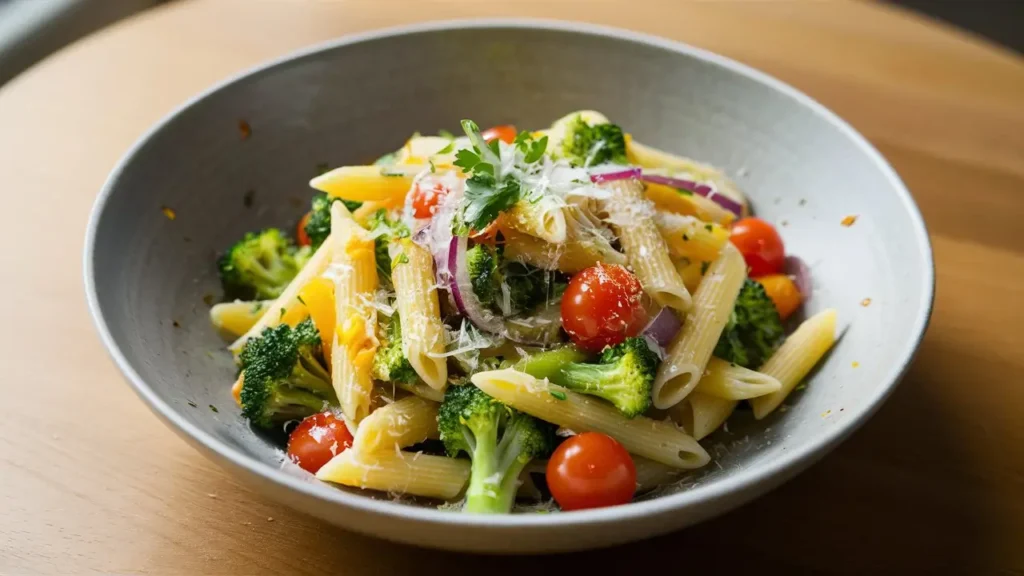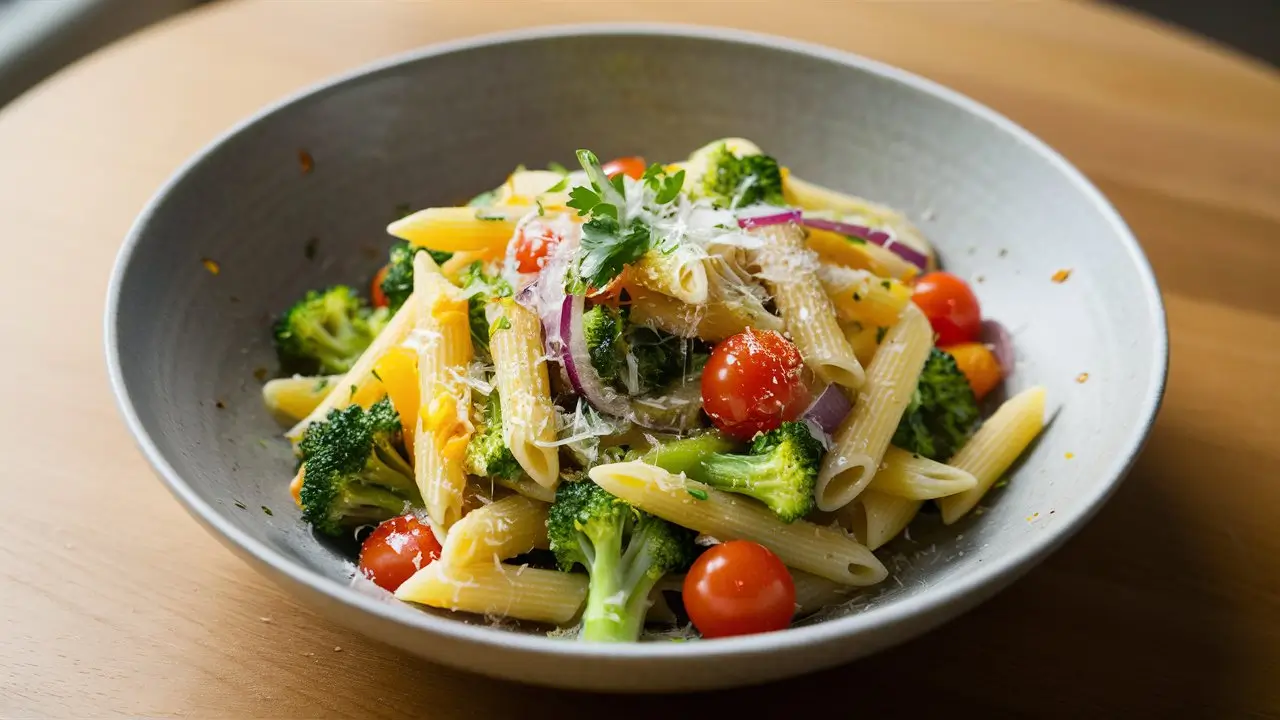Pasta Primavera is a celebration of fresh vegetables and vibrant flavors, tossed with perfectly cooked pasta and often finished with a touch of cheese or cream. This colorful dish is the embodiment of spring and summer cooking, but its comforting appeal makes it ideal year-round. Whether you’re looking for a quick weeknight dinner or a light yet satisfying entrée, Pasta Primavera brings balance, beauty, and bold flavor to your table.

Why You Will Love This Recipe
1. Vibrant and Colorful
Every forkful is bursting with beautiful, brightly colored veggies that make the dish as stunning as it is tasty.
2. Light Yet Satisfying
It’s a vegetarian dish that doesn’t feel like a compromise—hearty, flavorful, and filling.
3. Completely Customizable
You can tailor it to any season or preference by swapping out the vegetables or adding protein.
4. Quick and Easy
Dinner is on the table in about 30 minutes with simple prep and minimal cooking techniques.
Ingredients List
For the Pasta Primavera:
-
12 oz pasta (penne, fettuccine, spaghetti, or rotini work well)
-
2 tablespoons olive oil
-
1 tablespoon butter (optional for extra richness)
-
2 cloves garlic, minced
-
1 small red bell pepper, sliced thin
-
1 small yellow squash, sliced
-
1 small zucchini, sliced
-
1 cup broccoli florets
-
1 cup cherry tomatoes, halved
-
1 cup snap peas or green beans
-
½ cup grated Parmesan cheese
-
1 lemon (zest and juice)
-
Salt and pepper, to taste
-
Fresh basil or parsley for garnish
Optional Additions:
-
¼ cup heavy cream (for a creamy version)
-
Red pepper flakes (for heat)
-
Cooked chicken or shrimp (for added protein)
Timing & Servings
-
Prep Time: 15 minutes
-
Cook Time: 15 minutes
-
Total Time: 30 minutes
-
Servings: 4 servings
Step-by-Step Instructions for Pasta Primavera
Step 1: Prepare the Pasta
Bring a large pot of salted water to a boil. Cook the pasta according to package directions until al dente. Reserve 1 cup of pasta water, then drain and set aside.
Step 2: Sauté the Vegetables
In a large skillet, heat olive oil and butter over medium heat. Add garlic and cook for about 30 seconds until fragrant. Then, add bell pepper, squash, zucchini, broccoli, and snap peas. Sauté for 5–7 minutes until vegetables are tender-crisp.
Step 3: Add Tomatoes and Lemon
Stir in cherry tomatoes, lemon zest, and lemon juice. Cook for another 2 minutes just until the tomatoes begin to soften.
Step 4: Combine Pasta and Sauce
Add the cooked pasta to the skillet with the vegetables. Toss to combine, adding a bit of reserved pasta water to loosen the mixture and create a light sauce.
Step 5: Finish with Cheese and Seasoning
Add grated Parmesan, salt, and pepper. Toss again until the cheese is melted and the pasta is well coated. Adjust seasoning if needed.
Step 6: Serve and Garnish
Serve warm, topped with more Parmesan and fresh herbs like basil or parsley.

Choosing the Right Pasta
While you can use almost any pasta shape for Pasta Primavera, the type you choose affects the texture and experience.
Best Choices:
-
Penne or rigatoni: Great for catching bits of vegetables in the tubes.
-
Fettuccine or linguine: Ideal for creamier versions of the dish.
-
Rotini or farfalle: Adds visual interest and holds sauce well.
Avoid delicate pasta types like angel hair that can become mushy when tossed with hearty vegetables.
Vegetable Variations by Season
Spring/Summer:
-
Asparagus
-
Sugar snap peas
-
Zucchini
-
Bell peppers
-
Cherry tomatoes
Fall/Winter:
-
Roasted carrots
-
Brussels sprouts
-
Butternut squash
-
Kale or spinach
Mix and match based on availability and flavor preference. Roasting heartier veggies before adding them can intensify their flavor.
Add Protein (Optional but Delicious)
Want to make it a full meal with added protein?
-
Grilled Chicken: Slice and layer on top for a meaty finish.
-
Shrimp: Sautéed quickly in garlic and olive oil—pairs perfectly.
-
Tofu or Tempeh: For a vegetarian-friendly protein boost.
-
Chickpeas or White Beans: Add plant-based protein and fiber.
Simply prepare the protein separately and mix in when tossing the pasta.
Make It Creamy
If you’re craving something a bit richer, you can easily make a creamy Pasta Primavera.
How to Make It Creamy:
-
After sautéing the vegetables, reduce the heat and add ¼ cup heavy cream.
-
Let it simmer for 2–3 minutes before tossing in the pasta.
-
Add a bit of grated Parmesan for extra richness.
This transforms the dish into something that feels indulgent but still fresh.
Serving Suggestions
Pasta Primavera can be a standalone dish, but it pairs well with:
-
Garlic bread or focaccia
-
Simple side salad with vinaigrette
-
Grilled chicken or fish on the side
-
Glass of crisp white wine like Sauvignon Blanc
It’s also excellent for potlucks, lunchboxes, or meal prep.
Storage and Reheating
Storage:
Store leftovers in an airtight container in the refrigerator for up to 3 days.
Reheating:
Reheat gently in a skillet over medium heat, adding a splash of water or broth to keep it from drying out. Microwaving also works but can soften the vegetables more.
Avoid freezing as the texture of the vegetables can become mushy.
Tips for the Best Pasta Primavera
-
Cut Vegetables Evenly: So they cook at the same rate.
-
Don’t Overcook: You want the veggies to have a slight bite (al dente, like your pasta).
-
Use Fresh Lemon Juice: It brightens the entire dish.
-
Save Pasta Water: It’s key for creating a light, silky sauce.
FAQs
Is Pasta Primavera vegetarian?
Yes, it’s typically vegetarian. However, if you add chicken or shrimp, it becomes a meat dish.
Can I use frozen vegetables?
Fresh is best, but frozen vegetables can work in a pinch. Just thaw and pat dry before sautéing.
Can I make this dish gluten-free?
Yes! Simply substitute gluten-free pasta and check that your cheese and other ingredients are certified gluten-free.
Is this dish good for meal prep?
Absolutely. It’s easy to portion out for lunch or dinner and reheats well with a splash of water or broth.
Conclusion
Pasta Primavera is more than just a pasta dish—it’s a fresh, flexible, and colorful expression of the season’s best ingredients. Whether you’re enjoying it as a weeknight dinner or dressing it up for guests, it delivers flavor, beauty, and satisfaction in every bite.
From creamy versions to hearty protein additions and seasonal twists, the possibilities are endless. So grab your favorite pasta and a basket of veggies, and bring the garden right to your plate!
